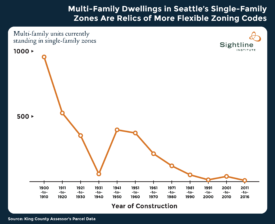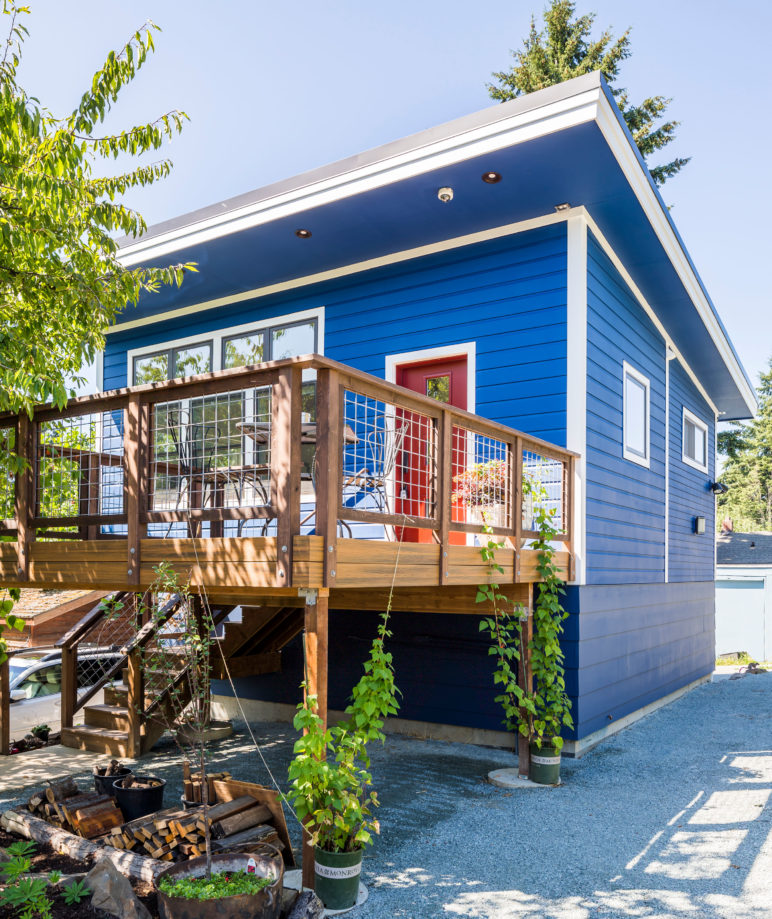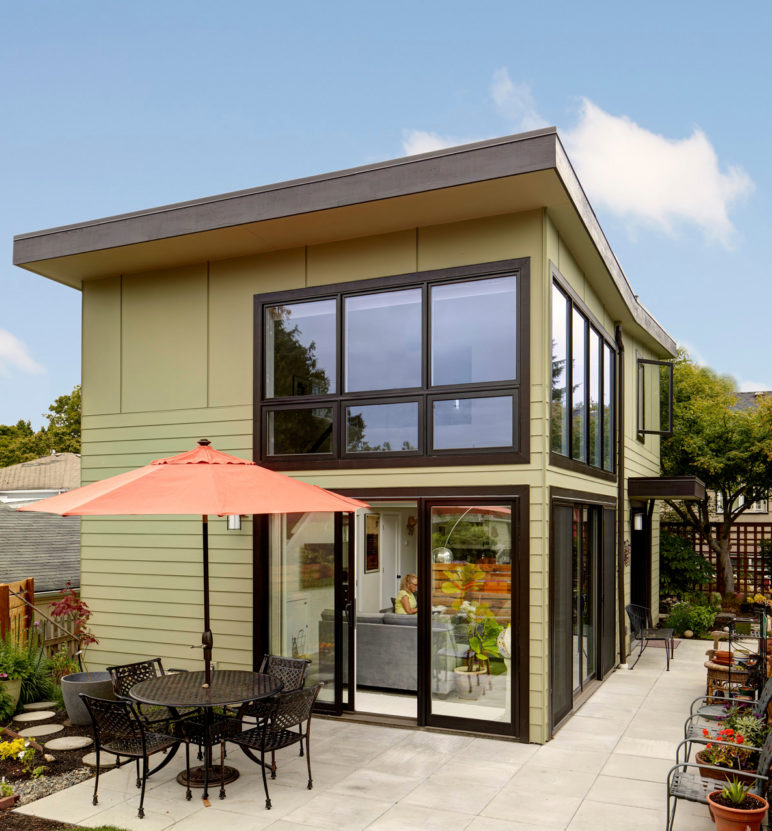Last week, one of the leading housing obstructionists in Cascadia’s biggest city took to the Seattle Times op-ed page to make a case against the city’s two most consequential pro-housing affordability reforms—and efforts in the state legislature to bring affordable home choices to communities across Washington. That case, published in the largest-circulation periodical in the region, is a fire hose of misinformation, a masterpiece of gish gallop, a pack—as Kurt Vonnegut would have put it—of foma.
Sightline is solutions-oriented. We write about the region’s slow-and-steady progress toward healthy, compact, sustainable, and affordable communities and study the multiple benefits of ensuring more housing options in Cascadia’s neighborhoods. We try to stay positive. But the tropes and myths about growth and housing that riddle this op-ed—no matter how predictable and distorted—all too often hold sway nonetheless, thwarting community solutions to ensure inclusive affordability in cities across our region and beyond. So we’re going to fisk this pack of foma, top to bottom.
The restrictive zoning he wants to enshrine reinforces a city of gated communities, exclusive and expensive.
The author opens: “Seattle’s prized neighborhoods…”
If by “prized” neighborhoods the obstructionist author means exclusive, he’s correct. The restrictive zoning he wants to enshrine reinforces a city of gated communities, exclusive and expensive. The gates may be invisible, but zoning rules that make it illegal for any other kind of home except the biggest and most expensive amount to walls around huge portions of the city, keeping away anyone who can’t—and won’t ever—afford to live inside them.
And continues: “…are under attack…”
Um. Hyperbolize much? Saying all single-family zoning is under attack reminds us of somebody stoking fear about a phony “invasion” to justify a border wall. If there’s a threat, it’s that exclusionary zoning pushes up prices and bodes the end of the kind of diverse, mixed-income neighborhoods that for many have defined Seattle. If the city instead allowed modest multi-dwelling homes like triplexes, Seattle might actually save more existing homes and fend off an actual invasion of sorts: the takeover by million-dollar McMansions of Seattle’s communities.

And so on: “…eliminate all single-family zoning…”
The op-ed’s author targets two reforms, both long-delayed outcomes of Seattle’s 2015 affordability plan. The first, adopted last week by the city council by unanimous vote, moderately upzoned parts of the city in exchange for new mandates for affordable housing (called Mandatory Housing Affordability or MHA) and, second, a proposal still pending before council to eliminate barriers to homeowners’ construction of accessory dwelling units (ADUs)—in-law apartments and backyard cottages.
The first thing to get straight: Seattle’s MHA rezones leave untouched 94 percent of Seattle’s single-family land. Now, if it’s true that allowing more than one home on a lot by legalizing ADUs ends single-family zoning, then by that definition, the state killed it off way back in 1994 when it legalized ADUs as part of the Growth Management Act. And then the author himself, by his own admission, drove the nail further into the coffin when he “helped draft” new ADU rules when Seattle began legalizing backyard cottages in 2006.
But it’s not just exaggeration, it’s a dog whistle intended to strike fear into otherwise reasonable residents about entirely reasonable solutions. As Erica Barnett put it, “allowing people to retrofit their basements to produce rental income or add an apartment for an aging relative does not constitute a ‘threat to single-family neighborhoods’; rather, it’s a way for homeowners to stay in the neighborhoods where they live, and provide new people with access to those neighborhoods—a rare commodity in a city where the typical single-family house costs more than three-quarters of a million dollars.”
In 2019 our families and households are knit together by more than blood.
“…confiscate property rights…”
Seriously: what!? Relaxing restrictions on homes do not confiscate property rights. It grants them.
“…and haven’t even bothered to ask if that’s OK…”
Whoa. That’s a McMansion-sized fabrication. For MHA, Seattle held more than 200 community meetings over a multi-year, multi-faceted outreach process. For ADU reform, Seattle also held community meetings and collected hundreds of comments from the public over a five-month period.
And let’s be clear, in survey after survey, housing affordability nears the top of the list of concerns held by Seattleites—and Washingtonians. The appetite for upzones is strong, especially among younger residents. City of Seattle outreach staff found receptiveness to loosening ADU rules in single-family neighborhoods and “interest from low-income homeowners, including POC [people of color] homeowners, in building ADUs,” noting that they were “overwhelmed by the level of response and interest in building ADUs.” AARP is a huge proponent of ADUs because they give older people the flexibility to age in their community. The Washington state legislature’s proposed ADU reform bill has support from elected officials, labor unions, and affordable housing advocates from all over the state.
“…[MHA] morphed into encouraging developers to buy their way out by paying ridiculously cheap fees-in-lieu…”
That sure sounds sinister! But in real life, from day one through MHA’s passage, planners set the fees-in-lieu to match what it costs developers to include affordable units in their buildings. “Ridiculously cheap?” From day one through passage, officials have been clear about setting the fees this way so that roughly half of projects would pay the fee and half would build affordable homes on-site. Look, Sightline does have concerns about the technical details of MHA, but the obstructionist’s claims are bunk.
“…which will result in a modest number of housing units…”
We’re talking about thousands of new subsidized homes for low-income families. Officials estimate that the fee-in-lieu option yields about three times as many affordable homes as the build-on-site option because the city can leverage the fees to win additional funding from outside sources. With a wink and a nod to those who love demonizing developers, the author bashes an option that actually puts more roofs over people’s heads.
“…shunted to the edges of our city.”
Building affordable housing can be economically and politically challenging in expensive neighborhoods, but Seattle’s Office of Housing has an exemplary record of distributing projects throughout the city—even in red-hot neighborhoods like South Lake Union. What really shunts the workers who make the city tick to the edges and beyond? Seattle’s high prices, due in large part to lack of modest, affordable, in-city options. And long commutes cost those families in time and budget and cost every one of us in this region in air pollution, traffic, and climate damage.
“…sacrificing true housing affordability.”
MHA creates subsidized homes for low-income families earning 60 percent of the area median income—in other words, truly affordable homes—homes that won’t materialize otherwise. Obstructing rule changes that would increase the city’s housing options is the most effective way to sacrifice affordability. The nearly three years of delay in adopting ADU reform caused by the two legal appeals filed by the author and his group likely prevented construction of over 700 ADUs.

“Among many ‘takings’…”
Liberalizing zoning rules is not a taking. It is a giving. Allowing ADUs gives homeowners more freedom and flexibility and adds modest, convenient rental options. It allows Seattle communities to add a range of homes for neighbors at different incomes and stages of life.
“…usurping Seattle’s autonomy to manage its own land-use decisions.”
Seattle’s land-use decisions shape the kind of city it will grow to be, and who can afford to live in it. Let’s be honest, though, about who’s been doing the usurping in Seattle: the broadly supported proposals for MHA and ADU reform have been hijacked by a tiny minority of residents, in some cases rallied and coached by this obstructionist author, through legal appeals that abused state environmental laws.
“…overreaching [state ADU] bill…”
From Seattle’s perspective, there’s nothing overreaching about Washington’s ADU bill, which is similar (as originally proposed) to the ADU reform city council will likely pass this summer. It’s nothing radical. It reflects modern best practices. Five members of the Seattle City Council have endorsed it. Most other Washington cities still have overly restrictive rules that stymie ADU production. A state ADU law will help ensure that all of Washington’s cities and towns work together and do their share for affordability in all our communities by relieving the statewide housing shortage.
“…no limitations on number of residents per lot.”
Building codes enforce a hard limit on the number of residents according to the size of the dwelling. The state’s bill prohibits additional limitations only on the number of unrelated residents—morally objectionable laws that discriminate against families with unconventional relationships and would likely be struck down if challenged in court. In 2019 our families and households are knit together by more than blood. These days many households are creative combinations, making ends meet together or sharing elder care or child-rearing duties.
“…erasing 150 years of our history.”
First, get the history right. And then take a good look at what that shameful history represents. Seattle didn’t adopt single-family zoning until 1923, and by 1920 had 315,000 residents. Historically, Seattle’s neighborhoods included a variety of small-scale multi-dwelling homes mixed in with houses. In 2019, it’s high time to reverse, not pay reverence to, much of the city’s history when it comes to housing and zoning, especially. Councilmember Lorena González recently reminded the council that racial covenants only ended in the 1940s and then redlining followed, both designed “to keep certain people out of certain areas of the city.” As a policymaker, she said, “it is my duty to undo this history and to support legislation to begin the process of dismantling… laws that are intended to exclude people who look like me…”
“…no parking [requirements]…”
Parking concerns are overblown and play—again—on people’s fears, fears cynically trumped up to toggle good-hearted neighbors away from their civic interest in shaping healthier, more sustainable communities and toward narrow, self-interested concerns. As for overblown, Seattle’s environmental study for ADU reform found no significant impacts on street parking. Oh, and let’s not forget that mandating off-street parking beyond what private individuals choose to install themselves makes homes less affordable and encourages driving in a region where cars are the single largest source of climate pollution.
…[no] long-term ownership requirements…”
Adding modest ADU rental homes to expensive neighborhoods advances housing equity no matter who builds them and regardless of whether the owner lives there too. In any case, Seattle’s environmental study determined that investors renting out a house and two ADUs is the least likely scenario, even in low-income neighborhoods. Furthermore, cities have no such restrictions on owners who rent out their detached houses. Nor do cities require owners to live in their multi-dwelling rental properties. Owner occupancy requirements that single out ADUs discriminate against renters, and are likely illegal.

“…no control over traffic…”
Seattle’s environmental study found no significant impacts on traffic. On the contrary, making sure Seattle’s neighborhoods have more affordable options near jobs and transit can reduce car trips and improve transit efficiency.
“[no] tree protections…”
The same tree protections for single-family houses would apply to houses with ADUs. In other words, no change. Plus, anyone who wants to save trees and the carbon sequestration they provide should favor efficient homes in existing neighborhoods near job centers. In-fill housing is our best defense against tree-killing sprawl and pollution.
READ MORE: No, Seattle’s Growth Boom Is Not a Tree Apocalypse
“…no provision for improvements in streets, sidewalks, schools, or our aging infrastructure.”
Most of Seattle’s single-family neighborhoods have lost population since the 1970s: their infrastructure is underused. Seattle planners estimated that ADU reform would increase the number of homes in single-family zones by just 2 percent over 10 years. These neighborhoods have plenty of room for more neighbors living in ADUs.
“Should we allow lame-duck politicians… to advance their personal ideological and unpopular land-use agendas?”
Work on MHA and ADU reform began more than four years ago, and the four Seattle council members who aren’t running for reelection this fall have all been supportive throughout their terms. Furthermore, both proposals would have passed more than a year ago if anti-housing activists, led by the op-ed author in one case, had not filed appeals.
“…accommodating population growth while preserving what makes living here such a blessing.”
Again, most of Seattle’s single-family areas have not accommodated population growth for decades and they won’t ever unless zoning laws free up housing options in those neighborhoods. The blessing is reserved for those who can afford it. As Seattle Times’ Mike Rosenberg reported, “Going back to 1995… just 8 percent of the city’s new housing has gone to the single-family zones that hold two-thirds of the city’s residential properties. So in reality, most of Seattle is not growing—only certain parts are. Single-family neighborhoods…are absorbing virtually no growth.”
“I helped draft the current regulations allowing in-law apartments and backyard cottages…”
The ADU rules the author helped draft are so restrictive that just 512 have been completed over the three years from 2016 to 2018—the height of Seattle’s building boom. A mere 1.5 percent of Seattle’s single-family homes have an ADU, compared with about one in three houses that have them in Vancouver, BC, where requirements are less burdensome. This ADU drought is why Seattle has pursued reform.
By nature, ADUs are modest homes tucked into existing neighborhoods, giving homeowners flexibility to age in community, care for family, and earn income from a small rental. They also represent just the kind of small, efficient, cheaper, convenient home options Seattle renters need to live near jobs, schools, transit, and parks—in neighborhoods otherwise perpetually out of reach. People want them, communities need them, but city rules get in the way.

“On behalf of every neighborhood, the Queen Anne Council appealed…”
The Queen Anne Community Council was the only neighborhood group that sanctioned the appeal of Seattle’s ADU reform. The council does not speak for any other Seattle neighborhood, nor can they speak for everyone in Queen Anne.
“…convert every single-family neighborhood to one-size-fits-all multifamily development…”
Single-family zoning—exclusively reserving neighborhoods for detached, one-unit houses on large lots with yards and driveways—is the epitome of one-size-fits-all! Loosening zoning is what creates housing diversity and shared opportunity. Our families, lives, budgets, and housing needs are not one size fits all. To retain affordable, mixed-income neighborhoods, Seattle needs rules that allow homes of all shapes and sizes to fit a range of incomes and households. The one-size-fits-all status quo is shutting out affordable options from the bulk of Seattle’s residential land.
“…degrading the quality of life for everyone…”
Everyone? Really? Only if by “everyone” you mean those privileged enough to live in neighborhoods where exclusive single-family zoning puts homes out of reach for everyone else—even middle-class families.
“…without performing one environmental impact study…”
Environmental claims against rules that encourage compact, affordable communities are empty. It’s another underhanded attempt to confound the moral equation of Seattle’s housing affordability solutions. Adding low-impact homes near where people work, shop, recreate, and go to school is one of the region’s best tools for reducing traffic and climate pollution, along with saving trees and open space by curbing sprawl.
That said, contrary to the op-ed’s claim, Seattle followed state rules and first conducted a “SEPA checklist,” an abbreviated study of environmental impacts that is standard for modest changes such as ADU reform. All other Washington cities that have liberalized ADU rules have only done a SEPA checklist, and not a full-blown environmental impact study.
“Queen Anne Council appealed the EIS in hopes of remanding the study back to planners for a transparent and real-world specific analysis.”
Seattle’s ADU EIS is by far the most detailed environmental impact review of ADU regulations ever conducted by a Washington city and, for that matter, probably any city nationwide. It will almost certainly prevail over the obstructionists’ baseless appeal.
“As we strategize how best to grow, let’s do so respectfully and inclusively.”
Inclusive growth is absolutely impossible when Seattle reserves three-quarters of land on which housing of any type may be built for the most expensive kind of homes: single houses on large lots. Preserving these rules is the paradigm case of exclusivity.
And to finish it off: “…our cherished single-family neighborhoods.”
There’s nothing wrong with cherishing your neighborhood, but together as a community, Seattle will decide who’s included and who’s left out. Zoning for more homes opens access to opportunity, to convenience, to quality of life—to schools, jobs, and community investments like transit. By doing so, Seattle is rightfully reevaluating who the “our” is when we talk about “our neighborhoods,” and what we cherish about them.
Hearings on the Queen Anne Community Council’s appeal of Seattle’s ADU Environmental Impact Statement begin at 9 a.m., March 25.


Comments are closed.